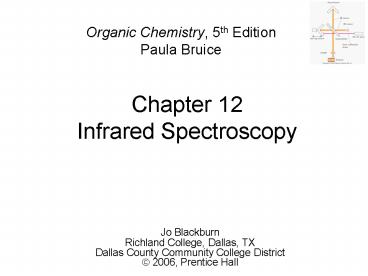Chapter 12 Infrared Spectroscopy - PowerPoint PPT Presentation
1 / 18
Title:
Chapter 12 Infrared Spectroscopy
Description:
Organic Chemistry, 5th Edition Paula Bruice Chapter 12 Infrared Spectroscopy Jo Blackburn Richland College, Dallas, TX Dallas County Community College District – PowerPoint PPT presentation
Number of Views:351
Avg rating:3.0/5.0
Title: Chapter 12 Infrared Spectroscopy
1
Chapter 12 Infrared Spectroscopy
Organic Chemistry, 5th EditionPaula Bruice
Jo Blackburn Richland College, Dallas, TX Dallas
County Community College District ã 2006,
Prentice Hall
2
Introduction
- Spectroscopy is an analytical technique which
helps determine structure. - It destroys little or no sample.
- The amount of light absorbed by the sample is
measured as wavelength is varied.
gt
3
Types of Spectroscopy
- Infrared (IR) spectroscopy measures the bond
vibration frequencies in a molecule and is used
to determine the functional group. - Mass spectrometry (MS) fragments the molecule and
measures the masses. - Nuclear magnetic resonance (NMR) spectroscopy
detects signals from hydrogen atoms and can be
used to distinguish isomers. - Ultraviolet (UV) spectroscopy uses electron
transitions to determine bonding patterns. gt
4
Electromagnetic Spectrum
- Examples X rays, microwaves, radio waves,
visible light, IR, and UV. - Frequency and wavelength are inversely
proportional. - c ln, where c is the speed of light.
- Energy per photon hn, where h is Plancks
constant, 6.62 x 10-37 kJsec.
gt
5
The Spectrum and Molecular Effects
gt
6
The IR Region
- Just below red in the visible region.
- Wavelengths usually 2.5-25 mm.
- More common units are wavenumbers, or cm-1, the
reciprocal of the wavelength in centimeters. - Wavenumbers are proportional to frequency and
energy. gt
7
The IR Region
- Wavelengths usually 2.5-25 mm.
- Calculate the wavenumbers associated with the IR
region in cm-1. - 10,000 mm 1 cm
8
The IR Region
- Wavelengths usually 2.5-25 mm.
- Calculate the wavenumbers associated with the IR
region in cm-1. - 10,000 mm 1 cm
- 2.5 mm 4000 cm-1
- 25 mm 400 cm-1
9
Molecular Vibrations
- Covalent bonds vibrate at only certain allowable
frequencies.
gt
10
Stretching Frequencies
- Frequency decreases with increasing atomic mass.
- Frequency increases with increasing bond energy.
gt
11
Vibrational Modes
- Nonlinear molecule with n atoms usually has 3n -
6 fundamental vibrational modes.
12
MOVIE TIME
- file///Volumes/USB20DISK/CH242/Labs/1-7-2007_7-2
5-17/Chapter_12/Present/Animations/IRStretchingand
Bending.htm - file///Volumes/USB20DISK/CH242/Labs/1-7-2007_7-2
6-28/Chapter_12/Present/Animations/IRSpectra.htm
13
Fingerprint of Molecule
- Whole-molecule vibrations and bending vibrations
are also quantized. - No two molecules will give exactly the same IR
spectrum (except enantiomers). - Simple stretching 1600-3500 cm-1.
- Complex vibrations 600-1400 cm-1, called the
fingerprint region.
gt
14
IR-Active and Inactive
- A polar bond is usually IR-active.
- A nonpolar bond in a symmetrical molecule will
absorb weakly or not at all.
15
An Infrared Spectrometer
gt
16
FT-IR Spectrometer
- Has better sensitivity.
- Less energy is needed from source.
- Completes a scan in 1-2 seconds.
- Takes several scans and averages them.
- Has a laser beam that keeps the instrument
accurately calibrated. gt
17
FT-IR Interferometer
gt
18
Interferogram
- The interferogram at the right displays the
interference pattern and contains all of the
spectrum information.
A Fourier transform converts the time domain to
the frequency domain with absorption as a
function of frequency.































